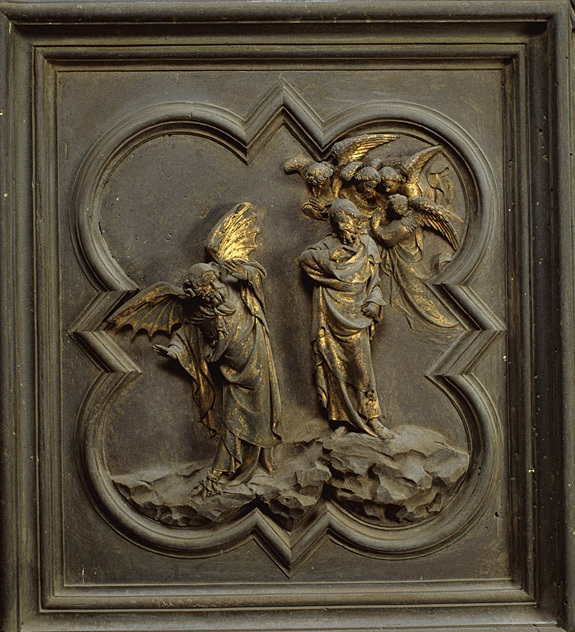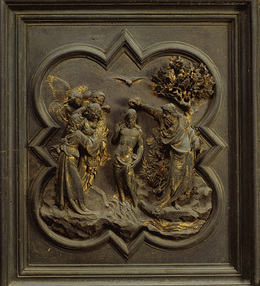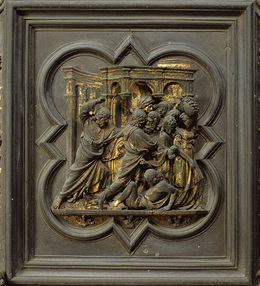Panel VI - The Temptation in the Wilderness
Panel details:
Mark 1:12-13: “immediately the spirit drove him into the wilderness.and he was there in the wilderness forty days,tempted by Satan, and was with the wild beasts;and the angels ministered to him.”
The temptation of Christ is chronicled in the synoptic gospels of Matthew 4:1-11,
Mark 1:12-13 and Luke 4:1-13. According to these texts, after Jesus received baptism he went into the wilderness where he remained for forty days and was tempted by the devil. All three evangelists narrate that immediately after Jesus received baptism in the Jordan river the holy spirit led him into the wilderness to meditate and fast for forty days and there he encountered the devil that thrice tempted the human nature of Christ. The first temptation consisted in trying to persuade Jesus to turn stones into bread; the second, enticing him with the possession of power and glory over the world and the third asking for a miracle to save his life. The three temptations aimed at challenging the different levels of human desire: the physical dimension of the body and its basic, biological needs; the intellect, appealing to its psychological thirst for power and, the third, testing faith in God. Jesus rejected the devil’s deceitful temptations with the force of the word, which induces man to renounce the earthly world and his covets, to obey the supremacy of God, the only one able to give life and salvation, who himself is the beginning of life, truth and love.
Mark’s account differs considerably from that of Matthew and seems to narrate
ancient traditions formed in the early church. In a comparison of the three
synoptic gospels they recount the temptation of Christ is the final task of
the three fold preparation required to commence his public ministry, which
included the preaching of John the baptist, the baptism in the Jordan river and
the temptation of Christ. The three synoptic gospels narrate that Jesus began
his public ministry upon having completed the three tasks, proclaiming that
the time had come and the kingdom of heaven was at hand. Further, the three
gospels narrate that Jesus spent forty days in the wilderness after being baptized
in the Jordan river. In Matthew’s version, the holy spirit “leads” (Matthew 4:1), in
Mark’s version it “drives” (Mark 1:12), and in Luke’s version it “led” (Luke 4:1-13), Jesus into the wilderness. Jesus fasted in the desert according to Matthew (Matthew 4:2), did not eat at all in Luke’s version (Luke 4:2) whilst Mark does not mention Jesus fasting.
- The temptations are the work of the “devil” in the gospels of Mathew 4:1,5,8,11
and Luke 4:2,3,5,13, whilst Mark indicated the name “satan” (Mark 1:13).
Matthew and Luke both fully describe the three temptations.
The first temptation is related to food, as the devil invites Jesus to turn stones
into bread using a defiant tone, “if you are the son of God”, spurring Jesus to use
his supernatural powers inappropriately for his own livelihood. Jesus answers
citing deuteronomy 8:3: “… that man shall not live by bread alone”. Luke adds the
remainder of the citation, “but man lives by every word that proceeds from the
mouth of the Lord”. The second temptation in the gospel of Matthew corresponds
to the third in the gospel of Luke. The devil instigates Jesus to throw himself
down from the highest point of the temple of Jerusalem, certain that the angels
would rescue him. In this instance, the devil inaccurately quotes psalm 90.11 to
12: he shall give his angels charge over you, and, in their hands they shall bear
you up, lest you dash your foot against a stone. The devil is provoking Jesus to
flaunt his powers to the people of Israel who, seeing him fall down from the
sky unharmed would acclaim him messiah. Jesus’ answer is based on deuteronomy 6:16: “it is written again, ‘you shall not tempt the lord your God’”. The description of the third temptation in the gospel of Matthew, corresponding to the second one in the gospel of Luke, recounts the devil showing Christ all the kingdoms of the earth and promising they will be his if Christ worships him. Matthew narrates that the devil ordered Christ to bow down to him, while in Luke’s version the devil claims that all the kingdoms of the world will be in his hands. Jesus answers again citing deuteronomy 6:13: “you shall fear the Lord your God and serve him, and shall take oaths in his name”.
Mark does not specifically describe the temptations; he merely succinctly
mentions them. Matthew’s narration ends as Jesus is casting the devil away while
the angels are approaching to serve Jesus. Mark recounts that the angels came to
minister him after referring that Jesus was with the wild beasts.
The synoptic gospels do not identify the exact location of the temptations.
according to tradition dating back perhaps to the fourth century, the “mountain
of temptation” where Jesus spent forty days, is considered the place now called
in arabic “Jabal Al-qarantal”, the “mountain of Quarantania”, located to the west
of Jericho.
The story of the temptation of Christ is steeped in symbolism. Fasting in the
wilderness for forty days alludes to the forty years during which the Jews
wandered in the desert after crossing the red sea, before they arrived in the
promised land, as narrated in the Book of Exodus. Moses remained on the
mountain for forty days before receiving the tablets of the law. The desert is a
place that lacks life; hence one is nearer to the experience of death and to the
experience of God. The references to animals and forests at the beginning and end of the episode of the temptations refer to Adam. Jesus, incarnate, has returned to earthly paradise which was destroyed by sin and consequently has become alifeless desert. The temptations of the devil seek to transcend the supremacy of God and replace it with human carnal pleasures (first temptation), defeated by the virtue of chastity; success and worldly power (second temptation) defeated by the virtue of poverty, and detachment from divine will (third temptation) defeated by the virtue of obedience. The three temptations reflect the inner struggle of Jesus to accomplish his mission, while at the same time the question about what is truly important in a person’s life emerges. The core objective of each temptation is quite clearly to reject God from our lives because everything else in our lives appears to be more important and therefore, God would besecondary, superfluous and even a burden.
The earliest representations of the temptation of Christ date back to the
carolingian era. Beginning in the ninth century, the episode was commonly
depicted in illuminated manuscripts. In romanesque art Jesus was quite often
depicted standing in front of the devil portrayed as a hideous monster, whereas
there was an angel standing behind Jesus protecting him and this theme is
represented in numerous sculptures and paintings in romanesque structures.
The most frequently depicted scenes of the episode have been the fasting and
solitude of Jesus in the wilderness in the company of animals and the three
temptations. In the fourteenth century, Duccio da Buoninsegna represented the
second and the third temptations on two panels of the predella of the Maestà
in Siena. The second panel represents Christ and the devil both standing, facing
each other on a balcony of a building, as the devil is commanding Jesus to throw
himself into the void. On the other panel, Christ is depicted on a mountaintop
overlooking a city as he is casting out the devil while the angels to his right
are prepared to serve him. Duccio da Buoninsegna intended to portray the devil
in his original essence of the rebel angel. In the fifteenth century, Lorenzo
Ghiberti represented this theme in his composition on the door of the baptistery
in Florence, portraying the devil with clawed feet and bat wings. From this
moment on depictions of the devil began changing from the monstrous forms
of previous centuries evolving into more human forms. The representation of
the tempter was quite a dilemma for artists, who seemed to waver between two
opposite configurations. Some artists imagined the devil in the most repulsive
form possible, usually totally covered in hair, horns sprouted on his forehead,
bat wings and clawed feet; other artists though, considered that in this guise
the devil would not have been able to deceive Christ, therefore, they depicted
him with a reassuring look, disguised as an angel or a monk, which was the
prevailing configuration at the beginning of the Italian renaissance. The fresco
by Sandro Botticelli in the Sistine Chapel represents the three temptations and
portrays the devil wearing a hooded cloak, similar to the Franciscan monks’
habit or to a hermit, leaning on a tau shaped staff, though the figure has clawed
feet and bat wings. In the third temptation, Christ is casting away the devil,
finally unmasked, his cloak fluttering in the air revealing his naked body and
evil aspect, while three angels behind Christ are preparing a meal at the table. In
the sixteenth century, Tintoretto’s painting ‘Temptation of the Bread’ portrays
Jesus set in a shed receiving the visit of the devil depicted in the form of an
angel with red wings, who is handing Jesus two stones. In the same period, Paolo
Veronese depicted the first temptation and the baptism of Jesus, which is now
located in the Pinacoteca in Brera. There are innumerable artistic representations
of the episode throughout the twentieth century that have interpreted the
episode either symbolically or with its psychological implications.
Lorenzo Ghiberti created the panel representing the temptation of Christ on the
North door of the Baptistery in Florence in the early stage of his work, adhering
to the international gothic style, particularly visible in the decorative nuances
of the draperies, the figures, and the rhythm of the composition, according
to Krautheimer’s studies (1937,1956). Ghiberti depicted the scene using medieval
iconography - The devil is portrayed in human form with bestial attributes such
as bat wings and clawed feet. The depiction of the devil occupies the right side of
the panel. The devil is standing, caught in the moment of surrender when Christ
is casting him out. The figure of Jesus is standing as well, expressing the moment
of the word that drives away the demon, emphasized by the gesture of his right
arm raised to his chest, his palm facing the devil for a moment before reaching
out to drive away satan. A group of angels is positioned behind Jesus, hovering
in the air observing and discussing the events taking place. The construction
of the scene develops on the diagonal from the top left at the height of the
angels to the right of the panel, where the devil is positioned lower than Jesus.
Ghiberti perfect contrasting of the gestures and the draperies of the figures in
clear gothic style create a dramatic energy conveying harmony and elegance to
the composition.



